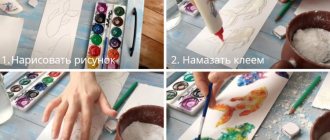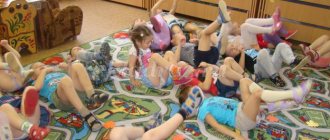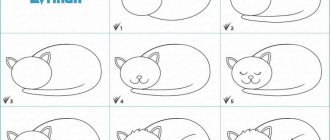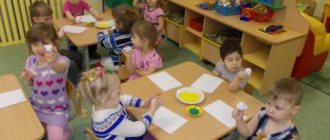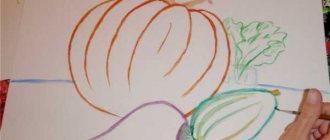Summary of GCD for drawing on the topic “My House”
author: Somova Svetlana Aleksandrovna
Teacher of MBDOU "DS "Golden Key"
Summary of GCD for drawing on the topic “My House”
RUSSIAN FEDERATION
YAMAL-NENETS AUTONOMOUS DISTRICT
MUNICIPAL BUDGETARY PRESCHOOL EDUCATIONAL INSTITUTION "KINDERGARTEN OF A COMBINED TYPE "GOLDEN KEY"
TARKO-SALE, PUROVSKY DISTRICT ______________________________________________________________________________
Abstract of GCD for drawing
in the middle group
on the topic “My Home”
prepared by: Somova S.A.
Summary of direct educational activities in drawing in the middle group on the topic “My Home”
Target:
- Teach children to draw houses, conveying the rectangular shape of the walls and the triangular shape of the roof.
- Develop the ability to supplement the image with elements based on impressions of the surrounding life.
- Activate children's vocabulary.
- To form in children an awareness of the need for a home for everyone.
- Arouse a desire to help others, a feeling of compassion.
Materials:
presentation of houses, paints, brushes, jars of water, napkins, puppy toy.
Literature:
T.S. Komarov “Lesson notes on fine arts in the middle group”, book by A. Barto
Integration of areas:
artistic creativity, communication, socialization, patriotic education, legal education.
Progress:
- Game situation “Let’s help a puppy in trouble.”
Vs:
Guys, look who I found near our door (brings in a toy puppy). His name is Druzhok. He's kind of sad. What happened, do you think? (children's assumptions)
- It turns out that the evil owners kicked him out of the house. What do we do? How can we help him in trouble?
Children's answers.
Vs:
I propose to draw houses for our guest. And he will choose one of them and settle in it.
- View a presentation of houses, highlighting the main parts of the house.
Vs:
First look at the screen. What is shown on the slides?
Children:
At home.
Vs:
Look carefully and tell me how they are similar and how they are different.
Children:
They have a roof, walls, windows, doors. They are different in color and height.
Vs:
What are houses made of?
Children:
Made of wood, brick.
Vs:
If a house is made of wood, then it is ... (wooden), if it is made of brick - ... (brick), if it is made of stone - ... (stone).
Vs:
What kind of houses do you live in?
Children's answers.
- Physical exercise “A puppy was running around the yard”
Vs:
Somehow our guest got bored. Let's cheer him up a little.
A puppy was running around the yard, He saw a piece of pie. He climbed under the porch and ate it, He fell down and began to sniffle.
- Drawing houses.
Vs:
And now we will go to paint houses for our guest.
House
We are at home. Let's draw one-story ones. Of course, they will be a little papery. Of course, they will not be very brick, but they will be white-walled, but they will be nice. For sure, no one will ever drive a puppy away from these houses.
Vs:
Who can tell me where to start drawing a house?
Children:
From the walls.
One child at an easel shows painting techniques at home.
Vs:
Let's get to work. Let's remember how to hold the brush correctly and how much paint to put on it. Don’t forget to rinse the brush thoroughly and blot it on a napkin.
Children's work.
- Exhibition of children's works. Analysis. Reflection.
Vs:
Let's see what kind of houses we got.
—Are all parts of the house drawn?
- Is it good to have your own home? Why?
Children's answers.
V-l reads A. Barto’s poem “At Home”
.
It’s raining continuously outside, But at home it’s warm and light. And you can calmly look at the brown downpours through the glass. Here you can hide from the heat, Save yourself from the frosty day. I’m drawn to a good, dear place - I’m drawn home.
Vs:
Now the puppy has a home, and not even one.
He liked all the houses. Therefore, he will live in everyone in turn. And it’s time for us to say goodbye to our guest. Goodbye, Buddy. Summary of GCD for drawing on the topic “My House”
Receptions and techniques that are used within the framework of the theme “Fairytale houses”
A fairy-tale plot immerses a child in an amazing, mysterious world of fantasy and folk wisdom; the fates of the characters in their favorite fairy tales remain in the memory for a long time. Together with the main character, the children rescue the princess, go in search of wonderful objects, and overcome treacherous obstacles on the way to their cherished goal. Traveling through a fairy-tale country, you can visit the castle of the good fairy or the clearing of an enchanted forest in front of Baba Yaga’s hut, or escape from the wolf in the safe house of the three little pigs. Bizarre fairy-tale houses become the calling cards of every story, full-fledged heroes, without which the image of a fairy-tale episode becomes empty and lifeless, and loses the charm of magic.
Classic techniques:
- Drawing with simple and colored pencils.
- Drawing with wax crayons.
- Drawing with felt-tip pens.
- Combined method (colored pencils and watercolors, felt-tip pens or wax crayons)
- Painting with a brush using gouache - a feature of this material is its opacity, which allows you to overlap layers with a new color. Thanks to this ability, gouache is a very popular material for decorative details.
- Painting with a brush using watercolors. Children continue to be taught how to correctly put paint on a brush and mix it to obtain the desired color shade.
Children's work using classical techniques (photo)
Drawing with colored pencils
Drawing with watercolors
Drawing with colored pencils
Drawing with wax crayons
Drawing with watercolors Drawing with watercolors
Drawing with watercolors
Drawing using a combined technique (wax crayons and gouache) Drawing with watercolors Drawing with gouache
Gouache drawing
Drawing with colored pencils
Drawing with watercolors
Drawing with wax crayons Drawing with watercolors
Drawing using combined techniques (felt-tip pens and colored pencils)
Drawing with colored pencils
Unconventional techniques
- Finger painting - older preschoolers independently come up with options for using finger painting in combination with classical techniques.
- Palm impression - older preschoolers apply paint to their palm with a brush and make an impression themselves, then complete the contours and details of the object.
- Drawing with rock salt, cereals by filling a silhouette previously smeared with glue or by sprinkling the contour of an object greased with glue.
- Bleeding drawing - the contours of an object are drawn with wax crayons or a candle on a blank sheet of paper, then the top layer is applied with watercolors of one or more colors.
- Stamping is an image of objects by applying an imprint on paper using a stamp and stencil (foam rubber swab, wooden blocks made from vegetables, fruits, waste material, etc.).
- Scratching is scratching the outlines of a design onto a surface primed with wax or paint.
- Threadography is the creation of an image from whole and finely chopped threads using glue.
- Monotype is a mirror transfer of an image from a base (cellophane, plastic surface, foil) onto a sheet of paper.
Children's pictures in non-traditional techniques (photo gallery)
Drawing with cotton swabs Drawing with cereals
Drawing using the technique of nitcography
Drawing with applique elements
Drawing using palm technique
Drawing with semolina
Drawing with a candle
Drawing on wet
Drawing using monotype technique
work using grattage technique
Drawing techniques in the senior group
Older preschoolers work hard to improve their drawing techniques with pencils, crayons and felt-tip pens, since shading strengthens the muscles of the hand, develops fine motor skills and the eye, and therefore helps prepare children for writing.
- Line - can be of different configurations (straight, wavy, spiral, broken, etc.) and helps to depict a contour, conveying the outline of the shape of an object, its size and proportional relationship of parts.
- Hatching is the simplest and most effective way of rendering color and drawing the texture of an object. The stroke is not only the most popular and accessible way to depict an object, but also an excellent simulator for the development of fine motor skills and coordination of movements. Types of shading: Chaotic - strokes are laid in a free direction, then modified by additional contour drawing of the silhouette of the object.
- Vertical - dense strokes are applied in a vertical direction. Adjusting the pressure force will allow you to achieve a smooth change of various color shades.
- Diagonal - most popular for sketching the silhouette of an object or background.
- Horizontal is a rather difficult technique from the point of view of technical execution, since it requires the child to constantly change the position of his hand during the drawing process.
- Shape-building is a complex and time-consuming option for drawing the shape of an object, for example, the sun, a flower or a cloud.
